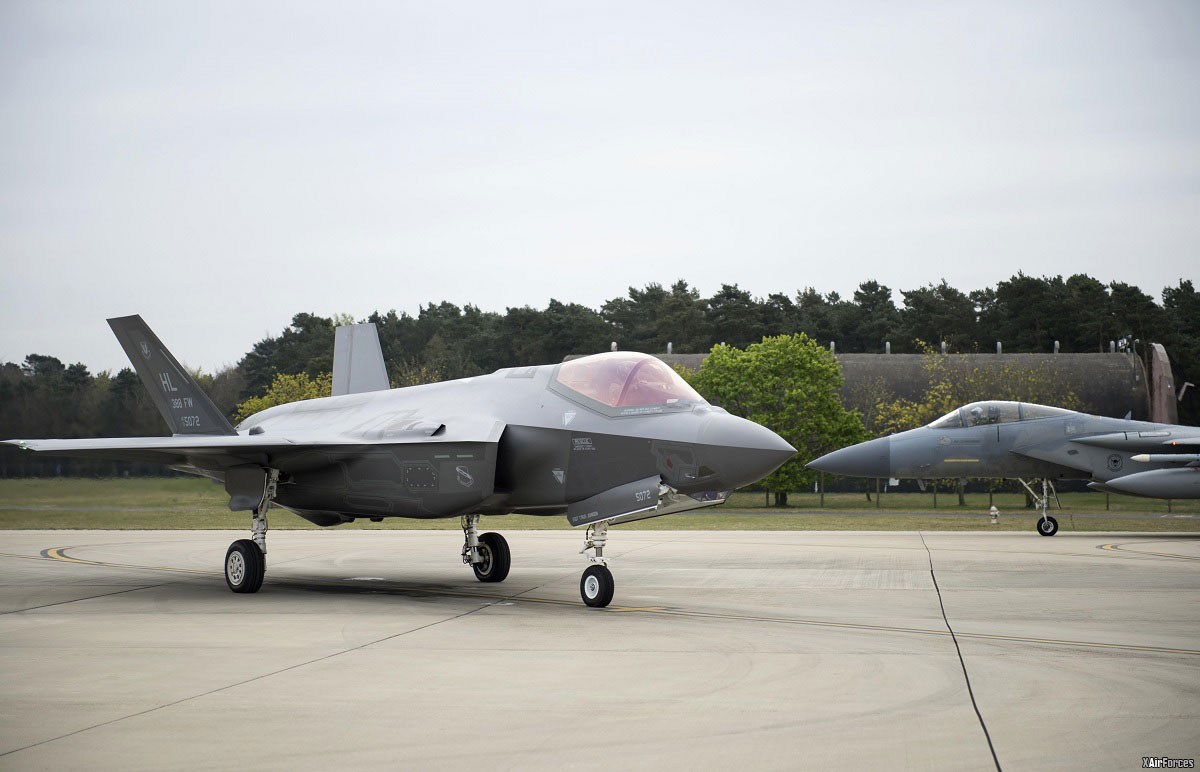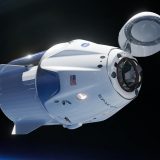U.S. Air Force Plans to Arm Stealth F-35s, F-15s and F-16s with the Ultimate Weapon
Advances in computer power, processing speed and AI are rapidly changing the scope of what platforms are able to perform without needing human intervention.
The Air Force and DARPA are now testing new hardware and software configured to enable 4th-Generation aircraft to command drones from the cockpit in the air, bringing new levels of autonomy, more attack options and a host of new reconnaissance advantages to air warfare.
Working with BAE Systems at Edwards Air Force Base, Calif., Air Force test pilots are combing ground-based simulators with airborne leer jets to demonstrate how 4th generation cockpit avionics can direct drones from the air, BAE Systems developers said.
“The airplane was structurally configured to allow us to take our autonomy hardware and connect it directly to the flight control system of the airplane,” Skip Stolz, Director of Strategic Development for Autonomy Control, told Warrior Maven in an interview.
Demonstrations with specially configured leer jets are intended as an interim step on route to integrating this kind of system into an operational F-15, F-16 or even F-35, developers said.
Using standard data-link technology, the jets operate with a semi-autonomous software called Distributed Battle Management, which enables new levels of compressed airborne data transfer, weapons integration and sensor operations, Stolz explained.
A recent Mitchell Institute paper, titled “Manned-Unmanned Aircraft Teaming: Taking Combat Airpower to the Next Level,” cites Distributed Battle Management software as a “system-of-systems future landscape for warfare, in which networks of manned and unmanned platforms, weapons, sensors and electronic warfare systems interact.”
The paper adds that DARPA and the Air Force Research Laboratory successfully tested DBM last year.
At the moment, the flight path, sensor payload and weapons disposal of airborne drones such as Air Force Predators, Global Hawks and Reapers are coordinated from ground control stations. However, due at least in part to rapid advances in autonomy, the concept of an autonomous or “semi-autonomous” wingman – is arriving even faster than expected.
DARPA, Air Force Research Laboratory and industry have been developing this concept for quite some time now. The current trajectory, or rapid evolution of processing speed and advanced algorithms is enabling rapid acceleration. A fighter-jet aircraft will be able to provide a drone with tasks and objectives, manage sensor payload and direct flight-path from the air.
For instance, real-time video feeds from the electro-optical/infrared sensors on board an Air Force Predator, Reaper or Global Hawk drone could go directly into an F-15, F-22 or F-35 cockpit, without needing to go to a ground control station. This could speed up targeting and tactical input from drones on reconnaissance missions in the vicinity of where a fighter pilot might want to attack. In fast-moving combat circumstances involving both air-to-air and air-to-ground threats, increased speed could make a large difference.
The Mitchell Institute essay also points to a less-frequently discussed, yet highly significant advantage offered by manned-unmanned teaming. Simply put, it could massively help mitigate the current Air Force bomber and fighter jet shortage. It is often mentioned that there simply are not enough Air Force assets available to meet current demand. As a result, having a massive fleet of fighter-jet operated drones could radically increase the operational scope of Air Force missions.
In particular, the Mitchell Institute paper mentions that ever since B-2 and F-22 production were cut well short of the initial intent years ago – the Air Force has since been forced to operate with insufficient air assets.
“A resource of 185 fighters (F-22s) and 20 bombers (B-2s) is fundamentally limited in world where their capabilities are in high demand. Airmen and their aircraft, no matter how well trained or technologically advanced, cannot be in two places at once,” the paper writes.
Fighter-jet controlled drones could also be programmed to fly into heavily defended or high-risk areas ahead of manned-fighter jets in order to assess enemy air defenses and reduce risk to pilots. Furthermore, given the fast-evolving efficacy of modern air-defenses, drones could fly into high-threat or heavily contested areas to conduct ISR, scout enemy assets and even function as a weapons truck to attack enemy targets.
Advances in computer power, processing speed and AI are rapidly changing the scope of what platforms are able to perform without needing human intervention. This is mostly developing in the form of what Air Force scientists describe as “decision aide support,” meaning machines will be able to better interpret, organize, analyze and communicate information to a much greater extent – without have humans manage each individual task.
“Different people have different views. We believe in a control-based approach that leverages AI but does not relinquish control to AI. As a pilot develops trust, he knows what that aircraft can do and tells it to do something,” Stolz said.
Currently, there is widespread consensus that, according to DoD doctrine, decisions regarding the use of lethal force should always be made by a “human-in-the-loop,” despite advances in autonomy which now enable unmanned systems to track, acquire and destroy targets without needing human intervention.
Nevertheless, the Mitchell Institute paper introduces a way to maintain this key doctrinal premise, yet also improve unmanned enemy attacks through what DARPA and the Air Force Research Lab call “adaptive kill webs.”
“DARPA and AFRL will form adaptive kill webs in which autonomous aircraft flying in collaboration with manned aircraft could receive inputs from a range of actors… such as a pilot of a manned aircraft,” the paper says.
By extension, the paper explains that – in the event that a pilot is shot down – drone command and control operations could shift to a larger manned “battle manager” aircraft such as an E-3 Airborne Warning and Control System or E-8 Joint Surveillance and Target Attack Radar System.
Another advantage of these technological advances is that one human may have an ability to control multiple drones and perform a command and control function – while drones execute various tasks such as sensor functions, targeting, weapons transport or electronic warfare activities, the former Air Force Chief Scientist told Warrior Maven in a previous interview.
At the moment, multiple humans are often needed to control a single drone, and new algorithms increasing autonomy for drones could greatly change this ratio. Air Force scientists have explained a potential future scenario wherein one human is able to control 10 – or even 100 – drones.
Algorithms could progress to the point where a drone, such as a Predator or a Reaper, might be able to follow a fighter aircraft by itself – without needing its flight path navigated from human direction from the ground.
Unlike ground robotics wherein autonomy algorithms have to contend with an ability to move quickly in relation to unanticipated developments and other moving objects, simple autonomous flight guidance from the air is much more manageable. Since there are often fewer obstacles in the air compared with the ground, drones above the ground can be programmed more easily to fly toward certain pre-determined locations, often called a “way-points.”
The Army has advanced manned-unmanned teaming technology in its helicopter fleet –successfully engineering Apache and Kiowa air crews to control UAS flight paths and sensor payloads from the air in the cockpit. Army officials say this technology has yielded successful combat results in Afghanistan. Army program managers have told Warrior Maven that manned-unmanned teaming enables Apache pilots to find and identify enemy targets, before they even take off.
Senior Air Force leaders have said that the services’ new next-generation bomber program, the B-21 Raider, will be engineered to fly manned and unmanned missions.
Also, in September of 2013, the Air Force and Boeing flew an unmanned F-16 at supersonic speeds for the first time at Tyndall Air Force Base, Fla. The unmanned fighter was able to launch, maneuver and return to base without a pilot.
Interestingly, the Mitchell Institute paper references a current Air Force-Boeing effort to engineer older F-16s so that they could function as drones.
“In 2017, Boeing, the prime contractor for the QF-16 charged with reactivating the legacy fighters from their desert storage and making necessary modifications, was awarded a $24.6 million contract to convert 18 F-16s into QF-16 target drones,” the paper writes.
At the same time, despite the speed at which unmanned technology is progressing, many scientist and weapons’ developers are of the view that human pilots will still be needed – given the speed at which the human brain can quickly respond to unanticipated developments.
“When it comes to certain kinds of decision making and things requiring an intuitive contextual understanding, machines are not yet able to do those things. Computers can process huge amounts of data,” Stolz said
There is often a two-second long lag time before a UAS in the air can respond to or implement directions from a remote pilot in a ground station, a circumstance which underscores the need for manned pilots when it comes to fighter jets, Air Force officials said.
Therefore, while cargo planes or bombers with less of a need to maneuver in the skies might be more easily able to embrace autonomous flight – fighter jets will still greatly benefit from human piloting, Air Force scientists have said.
While computer processing speed and algorithms continue to evolve at an alarming pace, it still remains difficult to engineer a machine able to make more subjective determinations or respond quickly to a host of interwoven, fast-changing variables.
However, sensor technology is progressing quickly, the point where fighter pilots will increasingly be able to identify threats at much greater distances, therefore remove the need to dogfight. As a result, there may be room for an unmanned fighter jet in the not-too-distant future, given the pace of improving autonomous technology.
“Different people have different views. We believe in a control-based approach that leverages AI but does not relinquish control to AI. As a pilot develops trust, he knows what that aircraft can do and tells it to do something,” Stolz said.
Source: By Kris Osborn – Warrior Maven (defensemaven.io ) – 12 November 2018



















